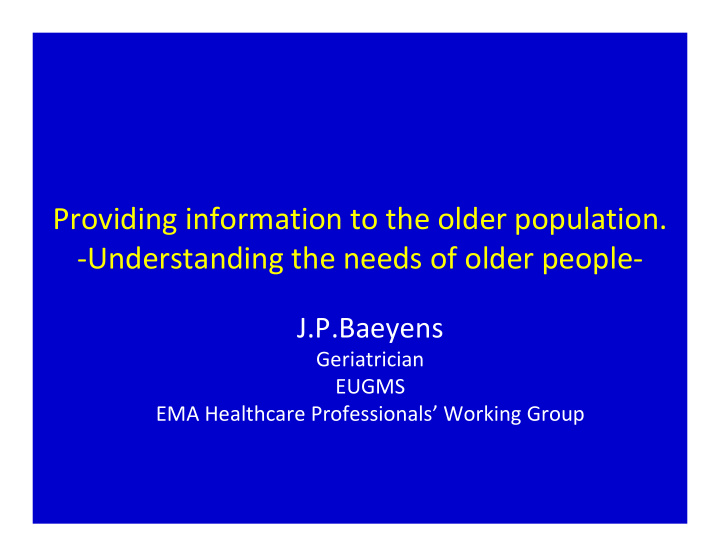



Providing information to the older population. -Understanding the needs of older people- J.P.Baeyens Geriatrician EUGMS EMA Healthcare Professionals’ Working Group
Who is OLDER??
United Nations definition 1963 • From 60 years on..... • Differentiation : – 3 rd AGE: 60 � 74 – 4 th AGE: 75 �
Time is changing... • Life expectancy is increasing every year with 3 months.... • In 40 years....it means 10 years....increase in life expectancy.
New situation in 2012 3 rd AGE 4 th AGE 1963 60 -74 ≥75 2012 70-84 ≥85
Treating different patients Younger patients Older patients • Complex • One disease situations • Treated according • Contradictory the guidelines guidelines • Randomized • No randomized controlled trials trials • No longterm follow up in trails
Different focus PHYSICIAN PATIENT • The Disease • Side effects • Time to an effect • Convenience • Cost
Dilemma for the Physician • Prescribing – for the disease ?? – for the patient ??
The endpoint of the process of providing information to the patient is a perfect adherence to the treatment... � Now it is often only 50%!
Main problems to meet the need of the older patients • 1. need for good data • 2. choosing the good channels to provide information • 3. other problems.
1. need for good data We have no data! • Older persons are excluded from clinical trials • In the clinical trials we see no “complex patients” • The clinical trials are limited in time: our patients are taking medicines often for many years...
Effect of a medicine review and education programme for older people in general practice. • Compliance in the intervention group was 91,3%, in the control group 79,5% (p < 0,0001) • The number of intervention group patients correctly understanding the purpose of their medicines increased from 58% to 88% on the third visit (in the control group 67 to 70%) (p <0,0005) Lowe CJ Br J Clin Pharmacol , 2000, 50,172- 175
2. choosing the good channels to provide information • Information to the patient + family/carers • Paper/ Website...: intelligible for the patient/carer/family • NOT a full list of all possible adverse drug reactions ( � the result is: they STOP the medication or never start it up!), BUT focus on most important benefits and the ONLY the most frequent ADR. • Need for better information of nurses (also directly by the pharmaceutical companies)
3. other problems • Social background... – Better result in patients who are better empowered and included in the decisions and negotiations of the treatment • Ethnicity • Vision problems • Hearing problems
THM • The patient and the carer have to be taken seriously, and need a full explanation about the benefits and the most important ADR’s. • There is an urgent need for serious data on medicines in older age. • All information channels available have to be used to improve the information of the patient: it looks effective. • The physicians, when prescribing medicines for the oldest old people, have to stop to prescribe for the “disease”, but have to prescribe for the “patient”.
Recommend
More recommend